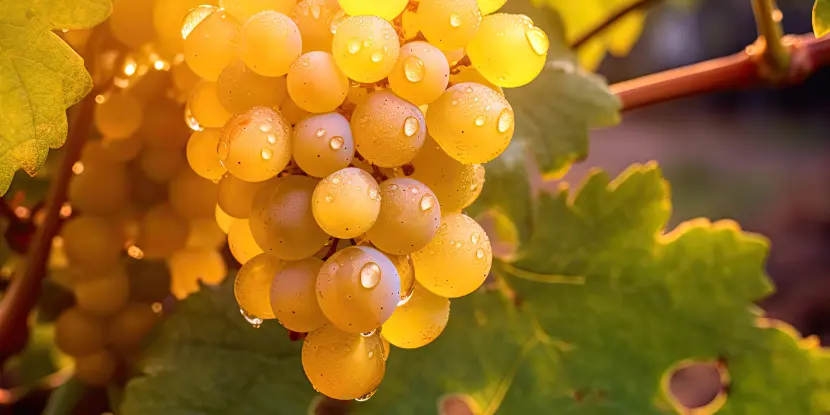Grapes are among the oldest cultivated plants in human history. Farming dates back over 8,000 years to the regions around modern-day Armenia and Georgia.
Cultivation boomed when humans discovered the fermentation process (surprise, surprise!). Ancient Egyptians, Greeks, and Romans developed the techniques that became the foundation of modern viticulture.
Grape Cultivation in California
California’s mild climate makes it one of the premier regions in the world for grape production. Today, the state accounts for over 80% of US grape harvest.
Southern California, in particular, has warm weather, a long growing season, and diverse microclimates optimal for grape farming.
That said, not every variety thrives in SoCal’s wilting summer heat.
Table Grapes for Southern California Gardens
Thompson Seedless
- A classic sweet green grape, also known as Sultana or Sultanina
- One of the most widely planted varieties in California
- Used for raisin production and as a table grape
Crimson Seedless
- Crisp and sweet with deep red skin
- Popular for snacking and juicing
- Suitable for hot, dry climates
- Resistant to powdery mildew and other diseases

Crimson Seedless grapevines grow well in hot, dry climates and are resistant to powdery mildew disease.
Red Globe
- Large, round, and juicy red grapes with a refreshing flavor
- Tolerant of heat and drought conditions
- Popular for both table consumption and wine production
Autumn Royal
- Black seedless variety with a deep purple color and sweet taste
- Late-maturing; ideal for Southern California’s extended growing
- Used for fresh eating and raisin production
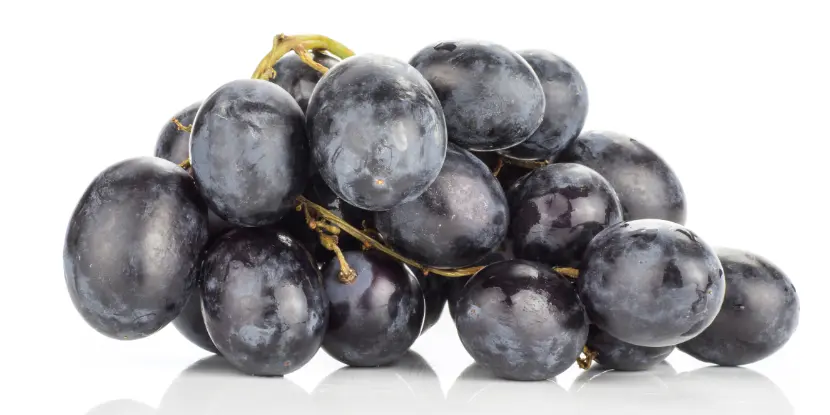
Autumn Royal grapes are a late-maturing variety ideal for SoCal’s extended growing season.
Red Flame (Flame Seedless)
- Reddish-pink seedless grapes with a sweet and tangy flavor
- Have a crisp texture and vibrant red color
- An excellent choice for fresh snacking
- Early ripening; ready for harvest in late summer
- Versatile for eating fresh, making juice, or cooking into jams
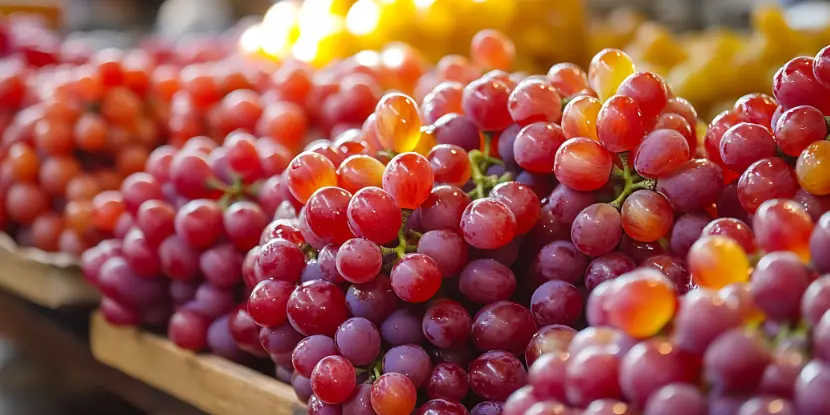
Red Flame grapes ripen early and are ready for harvest in late summer.
Princess
- Green seedless variety with a crisp texture and sweet taste
- Popular for table consumption
- Grows well in hot climates with low humidity levels
Black Monukka
- Dark purple-black seedless grapes with a rich, sweet flavor
- Known for their large size and chewy texture
- Ideal for snacking or including in desserts and salads
- Ripens mid to late season, usually in the fall months
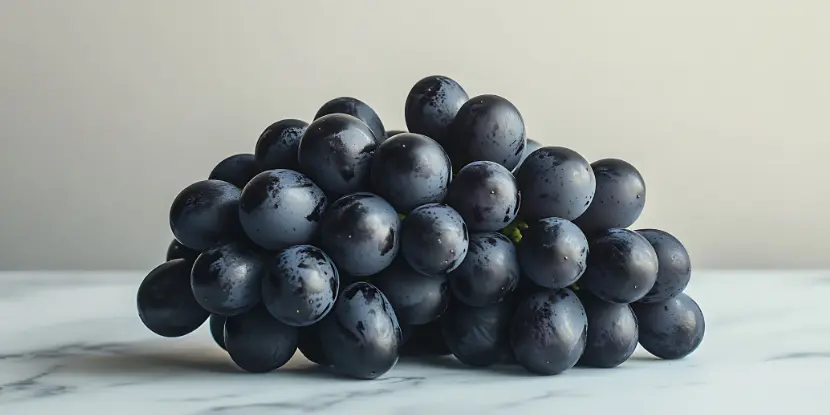
Black Monukka grapes are purple-black, seedless, and have a rich, sweet flavor.
Health Benefits of Grapes
Grapes are a nutritional powerhouse of antioxidants, vitamins, and minerals.
However, most commercial grapes contain chemicals. Grapes are among the fruits with higher pesticide residues; some remain even after washing.
Organic grapes can be costly, and choices are limited. But the grapes you grow organically in your garden will be chemical-free, and you’ll select only your favorite varieties for your plot.
What can grapes do for you, aside from filling the fruit bowl?
1. Improve Heart Health
Grapes contain polyphenols, which reduce inflammation, prevent blood clots, and promote heart health. The potassium in grapes can also lower blood pressure.
2. Boost Immune System
Grapes are loaded with antioxidants, vitamins, and minerals that strengthen the immune system and fight against diseases. The polyphenols in grapes can also reduce the risk of chronic diseases.

Grapes can boost heart and brain health.
3. Enhance Brain Function
Grapes contain resveratrol and flavonoids, which improve brain function and protect against neurodegenerative diseases like Alzheimer’s.
4. Aid Digestion
The fiber in grapes helps regulate digestion and prevent constipation. The skin’s insoluble fiber promotes a healthy gut microbiome (Beulah, don’t peel that grape!).
5. Maintain Healthy Skin
The resveratrol in grapes has anti-aging properties that benefit the skin. Grapes also contain vitamin C, which promotes collagen production and keeps skin firm and supple.
6. Improve Eye Health
Antioxidants like lutein and zeaxanthin are important for healthy eyes. These compounds in grapes protect against age-related macular degeneration and cataracts.
7. Aid Weight Management
With low-calorie and high water content, grapes make a perfect snack for anyone attempting to lose weight. Also, the resveratrol in grapes can reduce fat cell formation and improve metabolism.
Ideal Growing Conditions
Enough of the palaver — let’s get started!
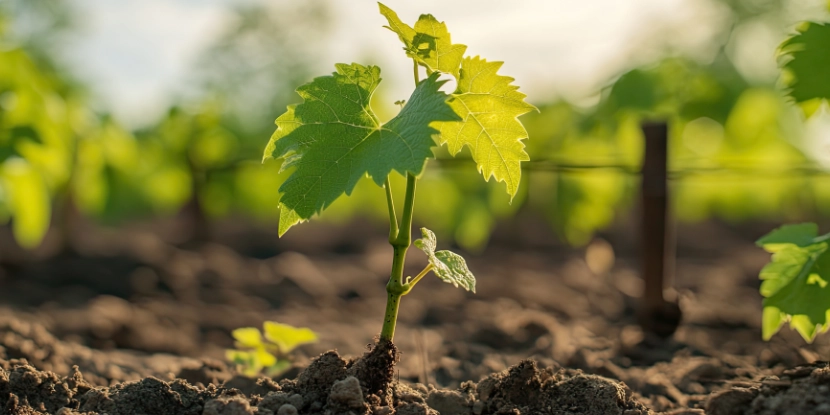
Every great grapevine starts with a sprout or sprig.
Light
- Grapes need at least 6 to 8 hours of direct sunlight daily.
- Plant your grapevines in a location with full sun exposure.
- If planted in an area with inadequate sunlight, the vines may produce fewer fruits or no fruit.
Soil
- Grapes do best in slightly acidic, well-drained soils (pH 5.5 – 6.5).
- Avoid planting grapes in areas with poor drainage, which can lead to root rot.
- Soil should be loose, fertile, and rich in organic matter.
Temperature
- Grapes prefer warm temperatures ranging between 60°F and 85°F.
- Southern California’s climate is naturally suited, but avoid planting in areas prone to frost.
Propagating Grapevines
You can grow your grapevines from cuttings or seeds. Propagating from cuttings is the easiest and most reliable method.
From Cuttings
- Choose a mature vine in winter while it’s dormant.
- Snip a 12″–16″ segment of a healthy cane with at least 3-4 nodes. Use clean, sharp pruners.
- Remove any tendrils or side shoots, leaving only the nodes.
- Place the cutting in potting soil or directly into the garden with the bottom nodes buried. Keep the soil moist but not waterlogged.
- New roots should develop within 6–8 weeks.
From Seeds
Growing from seeds is more time-intensive and less predictable, but here goes:
- Extract seeds from a ripe, disease-free grape.
- Place seeds in a moist paper towel in the refrigerator for 8–12 weeks.
- After stratification, plant the seeds about 1/2″ deep in small pots with well-draining soil.
- Keep soil slightly moist and in a warm, sunny location.
- Once seedlings are 8″–10″ tall, transplant them into your yard or garden.
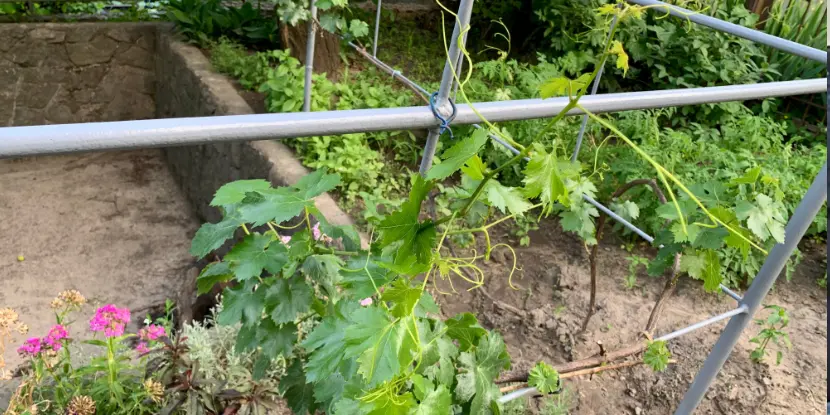
A steel support for grapevines. You can make your own out of bamboo, scrap wood and wire, etc.
Planting Grapevines in the Yard
- Find a sunny, well-draining location with enough space for vines to spread (6–8 feet apart).
- Enrich the soil with compost and ensure proper drainage.
- Dig a hole twice as wide as the root system and deep enough to bury the roots completely.
- For multiple plants, maintain spacing to provide airflow and prevent overcrowding.
- Insert a trellis or wire system to train your vines as they grow.
Grape Plant Care
Water
- Grapes need consistent moisture during their first year.
- Once established, water less frequently but deeply — about once a week during the growing season.
Fertilizer
- Grapes don’t require much fertilizer, but a balanced blend of nitrogen, phosphorus, and potassium can promote growth.
- Avoid fertilizing after the first year to prevent excessive vine growth.
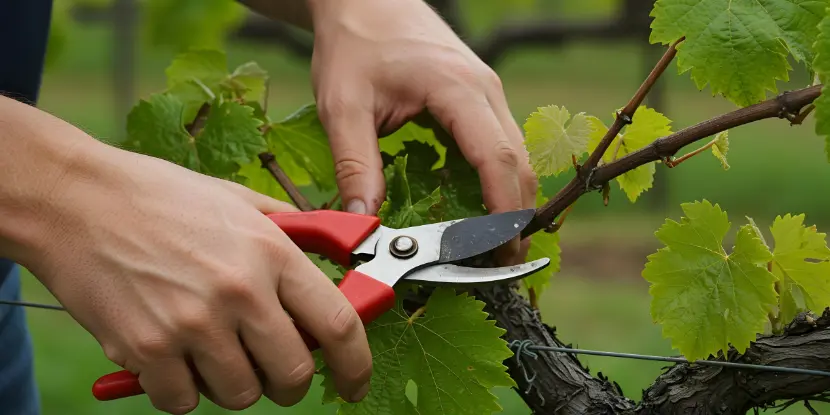
A gardener prunes a grapevine during the growing season.
Pruning
- Prune your grape plants in late winter or early spring before new growth begins.
- Remove dead or damaged branches and old or weak canes that won’t produce fruit.
- Light summer pruning can control excessive growth and encourage air circulation.
- Train your vines onto the trellis system by selecting the most vigorous stems and tying them in place.
Cane Pruning vs. Spur Pruning
- Cane pruning is ideal for grape varieties that require long canes to bear fruit. It involves selecting one or two of the strongest canes and cutting them back to a few buds. These canes will grow during the season and produce fruiting wood for the following year.
- Spur pruning works well for grape varieties that bear fruit on short canes. It entails cutting back the previous year’s growth to a few buds. The spurs left behind will produce new shoots and eventually bear fruit.
Pest & Disease Control
- Watch for common pests like aphids, spider mites, leafhoppers, and Japanese beetles.
- Use natural or organic methods to control these pests, such as introducing beneficial insects or applying insecticidal soap.
- Regularly check your plants for signs of disease, such as powdery mildew or black rot.
- If necessary, use neem oil or fungicides labeled for grapes to prevent and treat diseases.
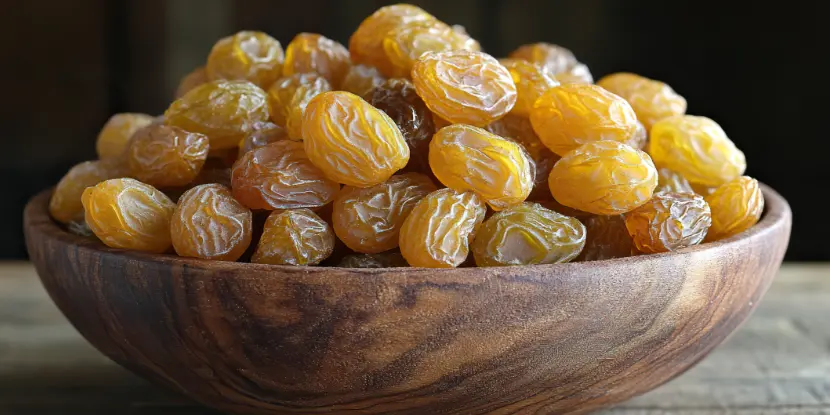
These delicious Sultana raisins came from Thompson grapes.
Harvesting Grapes
- Grapes are typically ready for harvest in late summer or early fall, depending on the variety.
- Test the ripeness of your grapes by sampling a few berries from different clusters. Ripe grapes will be plump, full-colored, and easily separate from the stem.
- Harvest in the morning when temperatures are cool.
- Use sharp pruning shears to remove entire clusters from the vine. Handle them carefully to avoid bruising the fruit.
Additional Tips
- Use netting or other protective coverings to protect your grapes from birds and pests.
- Regularly clean and sanitize your harvesting tools to prevent the spread of diseases.
- Avoid washing the grapes immediately after harvest. This can make them spoil faster. Instead, wash them immediately before the snack or meal.
- If growing multiple grape varieties, track their ripening times to ensure a timely and organized harvest.
- Store harvested grapes in a cool, dry place to maintain their freshness and quality.
FAQs: Growing Grapes
Q: Can I grow grapes in containers?
Yes, as long as the container is large (at least 15–20 gallons) and provides adequate drainage.
Q: How long does it take for grapevines to produce fruit?
Grapevines grown from cuttings or starts usually take 2–3 years to produce fruit.
Q: Do grapevines need pollinators?
Most grape varieties are self-pollinating, so there’s no need to worry about pollinators.
Q: How do I control powdery mildew?
Apply a fungicide or neem oil and ensure proper air circulation around your vines.
Q: What’s the best pruning technique?
It depends on the variety, but cane and spur pruning are commonly uses.
Q: Can I grow wine grapes at home?
Yes! Popular varieties like Cabernet Sauvignon and Pinot Noir can thrive with good care.


